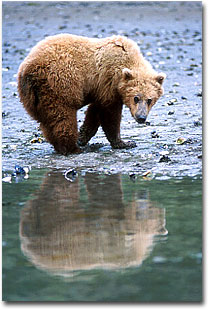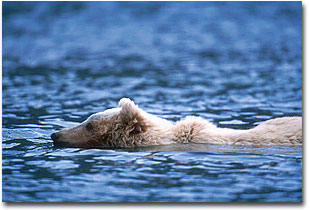|
The Camera Hunter®
Photography and Text Copyright Bill Silliker, Jr.
All rights reserved.
Nikon's Vibration Reduction Telephoto Zoom
Originally published in Outdoor Photographer, with a special update for NPN
Three years ago a wolf stepped off the taiga to pose on the paved road east of the Savage River in Denali National Park. The wolf then led us on an unforgettable journey. For the next twenty minutes we held back a train of traffic, creeping along at a respectful distance as the wolf strolled the road for three miles. Several times it stopped and looked back. Each time I could have bagged great images had there been enough light to handhold a telephoto lens. There was never time to grab a tripod. Finally the wolf stepped to my side of the truck and paused before slipping into the forest. She made a final statement by urinating before leaving us - stunned!
I have only memories of that wolf. Today I could show you her picture.
How? With the new AF VR Zoom-Nikkor ED 80-400mm f/4.5-5.6D lens from Nikon. The name tells a lot. AF means autofocus. ED says important lens elements are extra low dispersion glass, assuring the sharp images Nikkor ED lenses are known for. The aperture ranges from f4.5 at 80mm to f5.6 at 400mm. The final D says the lens provides exact subject distance for 3D Matrix metering computations.
VR Technology
And the VR? That stands for vibration reduction. Vibration reduction is Nikon's answer to image stabilization (IS), available to Canon shooters for the past year. Designed to offset camera movement, these technologies permit photographers to handhold at shutter speeds that before required a tripod for sharp results. Serious photographers know the rule of thumb: use a shutter speed at least as fast as the fraction made by 1 over the length of the lens. For a 400mm lens, that's 1/400th of a second.
With an IS or VR lens, that's all changed. And as with most of the back and forth advances in the technology competition between Nikon and Canon, with this new lens Nikon went one better. The manual says you can handhold this VR lens for sharp pictures "at shutter speeds approximately 3 steps slower than you ordinarily could".
What exactly does that mean? A Nikon technician queried for this article said it's worded that way because individual photographers can handhold at different shutter speeds depending on their steadiness. Using rule of thumb math, Nikon's manual states you can handhold 400mm at an unbelievable shutter speed of 1/60th of a second!
VR technology enables those with greater stability to handhold slower shutter speeds. One Nikon rep told me unofficially he's shot at 1/15th of a second for excellent results.
Field Use
All of which sounds great. But does it really work? And what's its capability otherwise? Is it as sharp as other Nikkor lenses? How fast does it autofocus on moving targets? Wanting to know all these things, I shot the VR lens on subjects as diverse as flying egrets in the Everglades, stock-still whitetails in Texas and Percival Puppy, my golden retriever camera testing partner.
I consistently got publishable images at 1/60th of a second handholding at 400mm as long as I gave the VR technology time to engage. After pushing the shutter button down partway, you do need to wait one second for the image to stop vibrating before shooting the first frame of any set. I never tried shooting slower on static targets because I honestly doubted I'd get publishable images at 1/60th of a second!
The lens distinguishes rapid motion from camera shake. That means you can use VR mode for panning moving targets. I shot egrets at 1/30th of a second for great results.
I also got sharp images with VR mode off with shutter speeds of 1/500th of a second and faster. Because it is neither an internal focusing (IF) nor a silent wave (SW) lens, moving from its closest focusing distance of 7.5 feet out to a distant target takes longer. But once in range, with a Nikon F5 driving the autofocus the lens captured birds flying parallel to the film plane, or better yet, a head-on charging golden retriever puppy!
Lens Details
The design employs 17 elements in 11 groups. With VR engaged, these elements vibrate to offset camera movement. That's why the manual says to turn off VR mode when on a tripod. A Nikon technician confirmed that with the lens locked down on a tripod, it's probably counterproductive to employ VR. But he added that VR reduces camera shake when panning on a tripod.
The lens employs the standard Nikon bayonet mount. The VR mode works on the Nikon F5, F100 and F80/N80 series cameras and the D1 digital camera. On the D1, the 35mm equivalent focal length is 120-600mm. Autofocus works on all Nikon AF bodies except the F3AF.
The lens weighs 48 ounces with its tripod collar attached. The collar rotates for vertical shooting. I took the collar off, as the lens holds better and weighs 5 ounces less.
The lens comes with a bayonet-mounted hood that locks rattle-free and is sturdy despite being made of a polycarbonate material. The lens barrel and mount are metal.
Focusing doesn't rotate the lens front, so it doesn't interfere with a polarizer, a 77mm size. You do have to remove the hood to rotate the polarizer. Those who don't want to shield the lens with hat or a hand can buy an optional hood designed to use with a polarizer.
The street price for this lens is around $1700.
New Era?
Because I'm most interested in camera hunting wild animals, I'm excited about what this new technology offers. The ability to nail static subjects and to either pan or blur moving subjects while handholding 400mm at 1/60th of a second, perhaps slower, without camera shake will permit photography of animals that we could only watch before. Who knows what exciting images we'll see from these capabilities?
I'll even make a prediction. Especially when paired with the new fine-grained films, this technology has changed wildlife photography forever. I'm just beginning to investigate how.
I do know one thing. If I ever see that wolf again, she's mine.
 NPN Update
NPN Update
That's the gist of my article on this lens published in the April 2000 issue of Outdoor Photographer magazine. Since that went to press, I've had additional time on target with the lens, including working with moose in the Maine woods and brown bears and bald eagles in Alaska. A few extra comments seem appropriate for this column, as there has been considerable discussion in the Forum about the pros and cons of this lens.
First, a warning for users of this lens. Read this sentences from the OP article again: After pushing the shutter button down partway, you do need to wait one second for the image to stop vibrating before shooting the first frame of any set. Read the lens manual and it tells you to do that. Otherwise, the VR doesn't get a chance to work and you get poor results, depending on the shutter speed. After that article was published, I got a bunch of e-mails from folks who said: "Ah-hah!"
Next, let's address the autofocus capability of the 80-400 VR lens. Matched with an F5 or one of its sister bodies that use the same AF system, it's seems as good at acquiring and staying with a moving target as the pre SW (silent wave) Nikkor AF lenses. It does require that the target you want to focus on has enough contrast and isn't overwhelmed by a brighter, closer object. In other words, it isn't as good as the more modern AF lens technologies Nikon has come out with, and it just as it isn't as fast.
But is it fast enough? It really depends on your subject choice.
For example, I used this lens for about 40% of the 262 rolls I shot on a recent trip to Katmai National Park. The target: brown bears that, while they moved around a lot, didn't do so all that quickly. They also contrasted well against the habitat. The advantage of being able to handhold 400mm and shoot bears from a moving boat with its vibrating engine netted me images that some missed as they were stuck on tripods with heavier artillery, and so lost opportunities until the boat stopped.
But if you want single lenses to work flying birds with, it wouldn't be this lens. I'd say get a long IF (internal focusing) Nikkor lens. Better yet, get an SW (Silent Wave) model of a Nikkor IF telephoto lens. As an aside, I've actually never switched from the EDIF AF 500 F4 Nikkor that preceded the SW version, finding that on an F5, the AF was fast enough to bag incoming flying bald eagles to do my book Just Eagles. It works for me.
 Next, let's look at quality. This new VR lens has the ruggedness and sharpness that Nikon is known for. I've found no deficiencies in either.
As for practicality of use, I love this lens. For example, when compared to the 80-200 Nikkor F2.8 lens, I'll take the 80-400 VR lens any time. It's lighter, and you can hang it over your shoulder to carry along with while using a longer lens on a tripod. I ditch the tripod mounting collar for this, and only put that on when I want to do a really slow shutter shot without using the VR technology. By the way, the lens manual says to shut the VR off when using the lens on a tripod, and that seems to be the best advice.
Next, let's look at quality. This new VR lens has the ruggedness and sharpness that Nikon is known for. I've found no deficiencies in either.
As for practicality of use, I love this lens. For example, when compared to the 80-200 Nikkor F2.8 lens, I'll take the 80-400 VR lens any time. It's lighter, and you can hang it over your shoulder to carry along with while using a longer lens on a tripod. I ditch the tripod mounting collar for this, and only put that on when I want to do a really slow shutter shot without using the VR technology. By the way, the lens manual says to shut the VR off when using the lens on a tripod, and that seems to be the best advice.
I also like the compositional possibilities that the range of this lens provides. That capability alone made this lens an asset on the Katmai shoot.
Most especially, I like the fact that I'm getting shots of subjects that I could only watch before. And when paired with the new Provia 400F, I'm getting shots I never dreamed I could bag. But that's a subject for another column, isn't it?
Catch yours in the good light.
BS-NPN
Comments on Bill Silliker, Jr.'s The Camera Hunter articles? Send them to the editor.
Maine wildlife & nature photographer Bill Silliker, Jr. – The Mooseman - photographed at many wild places in North America, with the results published in magazines internationally and in 9 of his own books. Bill was an instructor of wildlife and nature photography for L. L. Bean's Outdoor Discovery Program and a member of the Fuji Film Talent Team. Read more about Bill on the Camera Hunter archives page.


| 


